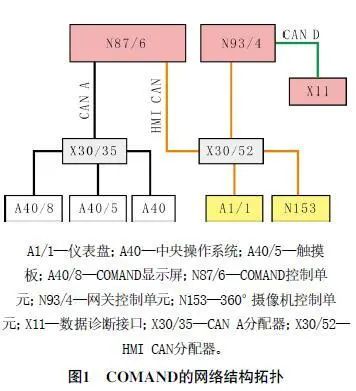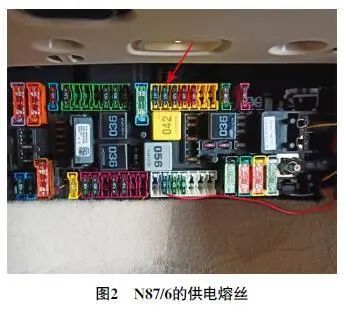Fault Phenomenon
A 2017 Mercedes-Benz V260L vehicle, equipped with a 2.0T engine, has a navigation system with version number NTG5.2 of the COMAND (Cockpit Management and Data) system, with a total mileage of approximately 35,000 km. The owner reports that the COMAND display is black, with no display or sound, and all the system’s switch buttons are non-functional.

Fault Diagnosis
After receiving the vehicle, a fault diagnostic tool was used for testing, and the diagnostic report shows that the COMAND control unit (N87/6) has a diagnostic result of “!”, indicating that the fault diagnostic tool cannot establish communication with the COMAND control unit. Possible fault causes include: power supply and grounding faults of the COMAND control unit; faults in the CAN bus related to the COMAND system; or a fault within the COMAND control unit itself.
Referring to the network topology of the COMAND system (Figure 1), the information from the COMAND control unit (N87/6) is transmitted to the gateway control unit (N93/4) via the HMI CAN (Human-Machine Interface CAN) bus, and then communicates with the diagnostic tool via the CAN D (Diagnostic CAN) bus. In the network topology of COMAND, N87/6 acts as a gateway, responsible for communication between the HMI CAN and CAN A (Remote Information Processing CAN). At the same time, N87/6 is also the main control unit of CAN A.
Before proceeding with disassembly, I carefully studied the diagnostic report and found an intriguing point: other control units on the CAN A network can communicate normally. According to Figure 1, if the main control unit N87/6 on the CAN A network cannot communicate, then other control units on the CAN A network would also be unable to communicate. After further analysis, I believe that the N87/6 is functioning normally as a gateway, meaning its power supply and grounding are normal, and the related network is also functioning properly. It is presumed that N87/6 is only partially damaged.
To verify my analysis, I removed the power supply fuse for N87/6 from the passenger side and the relay box (Figure 2). Using the diagnostic tool, I found that other control units on the CAN A network could not communicate, thus confirming the fault at N87/6.

Fault Resolution
The COMAND control unit was replaced, and after programming, data writing, and resetting, the test drive was conducted. The COMAND system returned to normal, thus resolving the fault.
Fault Summary
When encountering a fault where a control unit cannot communicate, the usual approach is to first check the control unit’s power supply and grounding, followed by testing the working waveforms of the related CAN bus. In this case, following such steps ultimately led to accurately identifying the fault point. However, this process involves disassembling many components and using various instruments, which can be time-consuming. Therefore, during fault diagnosis, especially when dealing with vehicle network system faults, one should not rush to the next step. Instead, carefully study the diagnostic report, take a holistic view, focus on details, and conduct in-depth analysis, as this can significantly improve diagnostic efficiency.

